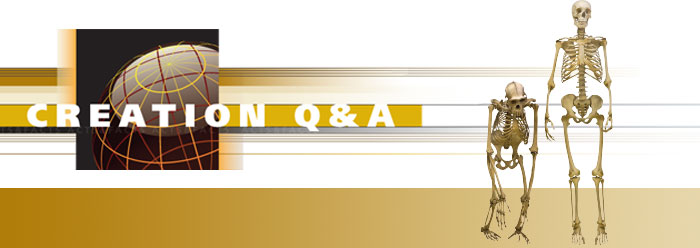Our anti-Bible world ridicules those who insist that Adam was a real, historical person, and consequently many Christians doubt Adam too. Old Testament professor John Walton recently wrote that perhaps “God chose one pair from the rest of the early hominids.”1 Do we come from apes or Adam? Two links between Adam and history reveal the relevance of the world’s first man.
Evolution’s defenders from inside and outside Christian circles reason that since science has “proven” evolution, and since evolution by default displaces a historical Adam, that on the authority of science Adam never lived. According to evolution, extinct apelike creatures gave birth to children with slightly more humanlike traits than themselves. The next generation did the same, and so on for countless generations until they gradually transformed into, well, you and me! In evolution’s history, we link to apes, not Adam.
However, biblical history links us to Adam. The Bible reveals that since each person inherits a sin nature from Adam, each of us commits sins that earn the death penalty. The Lord Jesus, who never sinned, paid that penalty for us so that “as in Adam all die, even so in Christ all shall be made alive.”2 If Adam never existed, then we have no basis for believing in a sin nature and no reason for Jesus to die in our place.
So, Adam matters! To the evolutionist, he must not exist, lest man be considered God’s special creation instead of the product of time and matter. To the biblical Christian, Adam must exist, lest the work of Christ on the cross and His resurrection from the grave be considered totally useless. So, which is it?
Scripture contains enough evidence to convince an honest seeker that Jesus, “the last Adam,”3 was just as real and relevant as the first Adam, but three sciences also support this.
First, the story of tiny changes transforming apes into men violates anatomy. Apes walk awkwardly when on two legs because God fitted their bones to also walk on all fours or swing in trees. If evolution adjusted any of these bones toward becoming more human, it would merely produce a deformed ape—one less likely to survive than its relatives.
Second, evolutionists dispute every proposed human ancestor fossil. A strange-looking fossil named Homo naledi supplies the latest example, with evolutionary anthropologists expressing doubt over whether or not it deserves to be named among humans.4 Future research may reveal it as merely a mashup of human and extinct ape parts.
Finally, genetics confirms Adam. About 100 new mutations accumulate every generation, so our generation holds a greater load of genetic “typos” than ever before.5 Mutations slowly erode information and set species on a collision course with extinction in only thousands of years. At this rate, why didn’t we all go extinct millions of years ago? We only have several thousand years’ accumulation of mutations in our genome, right in line with the Bible’s claim of Adam as our forefather.
Anatomy, paleontology, and genetics confirm that we came from Adam and Eve, not animals. This gives us even more confidence in the reality of “Adam, who is a type of Him who was to come.”6
References
- Walton, J. H. 2015. The Lost World of Adam and Eve. Downer’s Grove, IL: InterVarsity Press, 177.
- 1 Corinthians 15:22.
- 1 Corinthians 15:45.
- For example, see Chris Stringer’s comments in Ghosh, P. New human-like species discovered in S Africa. BBC News. Posted on bbc.com September 10, 2015, accessed October 7, 2015.
- Kong, A. et al. 2012. Rate of de novo mutations and the importance of father’s age to disease risk. Nature. 488 (7412): 471-475.
- Romans 5:14.
* Mr. Thomas is Science Writer at the Institute for Creation Research.



















